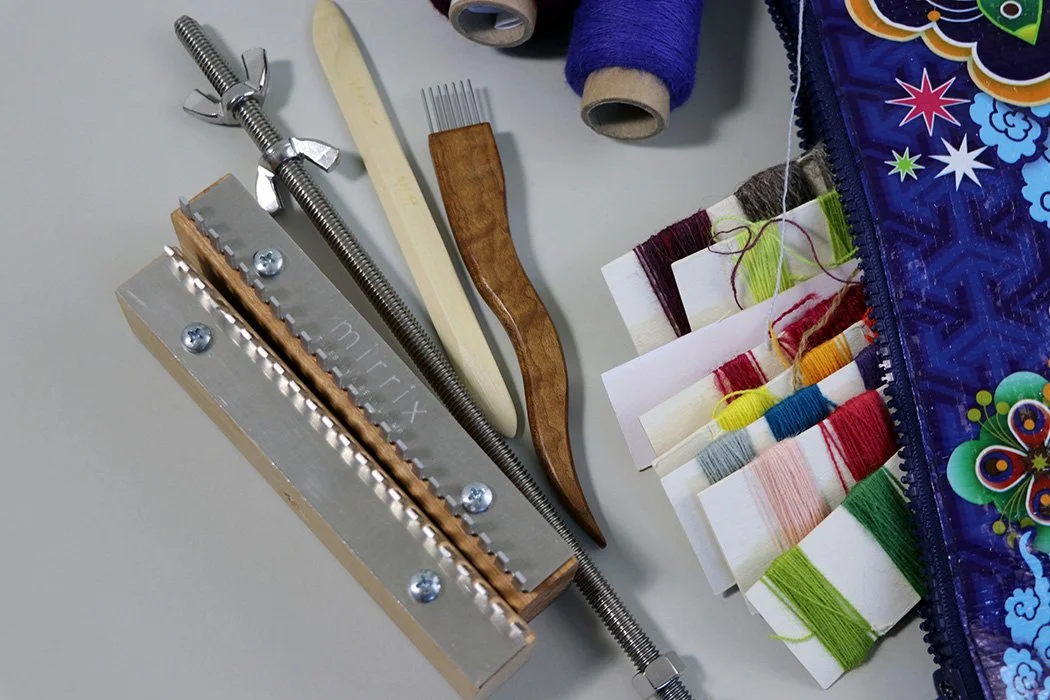Learning a new art or craft can mean that you need to purchase some supplies. The hard thing is knowing what you actually need when there are so many options. Below is a list of equipment and yarns which I’ve seen be very successfully used by beginning tapestry weavers. Some people will use the same materials for their whole weaving career!
Questions from the Book: Ease of weaving and loom length
What does loom length have to do with it?
Many of you are now working through my book, The Art of Tapestry Weaving, and I’ve been answering some of your questions here on the blog. One recent question from Zach was about how much warp you need to leave for various finishing techniques on the Mirrix Saffron loom. This question got me thinking about loom length and the video below was the result.
Loom length is something that I don’t hear tapestry instructors talking about a lot. Those of us who have been weaving for a long time intuitively understand the limitations of a short warp. But for new weavers, it isn’t something you’d automatically think about.
What do you need to get started with tapestry weaving?
Tapestry weaving can seem like a pursuit that requires A LOT. A lot of equipment, materials, and knowledge.
It doesn’t have to be that way. Weaving tapestry can be quite simple and your materials and equipment do not have to be complicated. If you want to learn tapestry weaving, below are some suggestions for how to get started. There are also many resources for people already deep into the tapestry experience, but this post is for people who are pretty new to tapestry weaving.
At the end of the post is an actual list you might use to shop with.
Arras vs. Mirrix
The Schacht Arras tapestry loom
This is a great loom. I love how beautiful the wood is. The product is thoughtfully designed and works really well for tapestries 20 inches wide or less. The optional beam assembly (not yet tested by me) would allow you to weave tapestries as long as you want or warping continuously, you can weave something about 36 inches long comfortably. You could probably push the warp farther by moving the shedding mechanism higher or taking it off, but it will do a piece this big comfortably.
This loom is not small nor very portable. It won’t serve your needs if you need to fly to workshops or take it along on your camping trip. But if you want a constant companion in your studio and want to weave things 20 inches wide or narrower, this loom is a great option. I believe the price to be more than fair and quite a bit less than I anticipated when I was weaving on the prototype. This loom is a great value for the price. If you want a loom that will last for the rest of your life, will look and feel great to weave on, and offers flexibility in terms of longer warps with the optional beam kit, this loom is well worth serious consideration.
The Saffron Pocket Loom has landed
I have grown quite a collection of small looms over the last few years. I have some favorites and you can see some of them in THIS blog post. But the new kid on the block is definitely Mirrix’s Saffron Pocket Loom.
….
This loom is small. And it comes apart into 3 pieces—the top, bottom, and threaded rod. For most people that might not be noteworthy, but in my life before coronavirus, I traveled a lot. My suitcase space when I’m traveling to teach is precious and bringing multiple small looms actually takes up quite a bit of room. The Saffron is tiny when disassembled which immediately led me to think that maybe I COULD provide small looms for relevant workshops now. Because I could fit 12 of these in a suitcase with no problem. I love this aspect of this loom.
But the real beauty of this loom is that it has tensioning. I don’t know of any other loom this small that provides a tensioned warp. This loom does it really well through a simple threaded rod. After warping, the tension can be increased by simply loosening the top nut and tightening the one under the top bar of the loom. When final tension is achieved, the top nut can be snugged up against the top bar and you have excellent tension. I never thought I’d see a loom of this size with adjustable tension. Being able to adjust the tension on a small piece is so wonderful.
Thanks for rocking my world Mirrix.
Tapestry looms: 5 things you need to know
I’ve written a lot about tapestry looms over the years. I’ve linked to some of those posts below. I get a lot of questions from new weavers about looms and which one might be the best for them. I’d like to summarize some of the things to look for in a tapestry loom. After that, the posts below will lead you to more information about the loom you’re interested in.
I have started categorizing tapestry looms this way.
Untensioned frame looms: these are generally small looms that do not have a tensioning device. Examples are the Schacht Easel Weaver and the Handywoman Loom.
Tensioned frame looms: These are looms that could be larger than the untensioned frame looms that have a tensioning device. Examples are the Mirrix and the Glimakra Freja loom.
Beamed looms: These are looms that have two beams to hold the warp and the woven cloth. Examples are the Harrisville Rug Loom and the Tissart tapestry loom.







